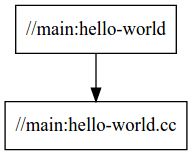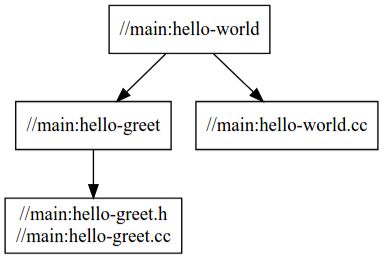Bazel入门:编译C++项目
官网:https://www.bazel.build
Github: https://github.com/bazelbuild/bazel
最近用到tensorflow的时候遇到了个新的编译工具Bazel,踩了无数坑之后终于决定还是系统地学习一下这货。
Bazel是一个类似于Make的编译工具,是Google为其内部软件开发的特点量身定制的工具,如今Google使用它来构建内部大多数的软件。Google认为直接用Makefile构建软件速度太慢,结果不可靠,所以构建了一个新的工具叫做Bazel,Bazel的规则层级更高。
下面就以C++和Bazel结合的例子理解一下Bazel的工作原理。
Install
安装过程请参考:http://bazel.io/docs/install.html
建立工作区(workspace)
Bazel的编译是基于工作区(workspace)的概念。工作区是一个存放了所有源代码和Bazel编译输出文件的目录,也就是整个项目的根目录。同时它也包含一些Bazel认识的文件:
- WORKSPACE文件,用于指定当前文件夹就是一个Bazel的工作区。所以WORKSPACE文件总是存在于项目的根目录下。
- 一个或多个BUILD文件,用于告诉Bazel怎么构建项目的不同部分。(如果工作区中的一个目录包含BUILD文件,那么它就是一个package。)
那么要指定一个目录为Bazel的工作区,就只要在该目录下创建一个空的WORKSPACE文件即可。
当Bazel编译项目时,所有的输入和依赖项都必须在同一个工作区。属于不同工作区的文件,除非linked否则彼此独立。
理解BUILD文件
一个BUILD文件包含了几种不同类型的指令。其中最重要的是编译指令,它告诉Bazel如何编译想要的输出,比如可执行二进制文件或库。BUILD文件中的每一条编译指令被称为一个target,它指向一系列的源文件和依赖,一个target也可以指向别的target。
举个例子,下面这个hello-world的target利用了Bazel内置的cc_binary编译指令,来从hello-world.cc源文件(没有其他依赖项)构建一个可执行二进制文件。指令里面有些属性是强制的,比如name,有些属性则是可选的,srcs表示的是源文件。
cc_binary(
name = "hello-world",
srcs = ["hello-world.cc"],
)使用Bazel编译项目
Bazel提供了一些编译的例子,在https://github.com/bazelbuild/examples/,可以clone到本地试一下。其中examples/cpp-tutorial目录下包含了这么些文件:
examples
└── cpp-tutorial
├──stage1
│ └── main
│ ├── BUILD
│ ├── hello-world.cc
│ └── WORKSPACE
├──stage2
│ ├── main
│ │ ├── BUILD
│ │ ├── hello-world.cc
│ │ ├── hello-greet.cc
│ │ ├── hello-greet.h
│ └── WORKSPACE
└──stage3
├── main
│ ├── BUILD
│ ├── hello-world.cc
│ ├── hello-greet.cc
│ └── hello-greet.h
├── lib
│ ├── BUILD
│ ├── hello-time.cc
│ └── hello-time.h
└── WORKSPACE可以看到分成了3组文件,分别对应本文中的3个例子。在第一个例子中,我们首先学习如何构建单个package中的单个target。在第二个例子中,我们将把整个项目拆分成单个package的多个target。第三个例子则将项目拆分成多个package,用多个target编译。
1. 编译你的第一个Bazel项目
首先进入到cpp-tutorial/stage1目录下,然后运行以下指令:
bazel build //main:hello-world注意target中的//main:是BUILD文件相对于WORKSPACE文件的位置,hello-world则是我们在BUILD文件中命名好的target的名字。
然后Bazel就会有一些类似这样的输出:
INFO: Found 1 target...
Target //main:hello-world up-to-date:
bazel-bin/main/hello-world
INFO: Elapsed time: 2.267s, Critical Path: 0.25s恭喜,这样你的第一个Bazel target就编译好了!Bazel将编译的输出放在项目根目录下的bazel-bin目录下,可以看一下这个目录,理解一下Bazel的输出结构。
现在你可以测试你刚刚生成的二进制文件了:
bazel-bin/main/hello-world2. 查看依赖图
一个成功的build将所有的依赖都显式定义在了BUILD文件中。Bazel使用这些定义来创建项目的依赖图,这能够加速编译的过程。
让我们来可视化一下我们项目的依赖吧。首先,生成依赖图的一段文字描述(即在工作区根目录下运行下述指令):
bazel query --nohost_deps --noimplicit_deps 'deps(//main:hello-world)' \
--output graph这个指令告诉Bazel查找target //main:hello-world的所有依赖项(不包括host和隐式依赖),然后输出图的文字描述。再把文字描述贴到GraphViz里,你就可以看到如下的依赖图了。可以看出这个项目是用单个源文件编译出的单个target,并没有别的依赖。
好的,到目前为止,我们已经建立了工作区,编译了一个项目,并且查看了它的依赖。接下来让我们加点难度。
3. 多个target的编译
单个target的方式对于小项目来说是高效的,但是对于大项目来说,你可能会想把它拆分成多个target和多个package来实现快速增量的编译(这样就只需要重新编译改变过的部分)。
首先我们来尝试着把项目拆分成两个target。看一下cpp-tutorial/stage2/main目录下的BUILD文件,它是这样的:
cc_library(
name = "hello-greet",
srcs = ["hello-greet.cc"],
hdrs = ["hello-greet.h"],
)
cc_binary(
name = "hello-world",
srcs = ["hello-world.cc"],
deps = [
":hello-greet",
],
)我们看到在这个BUILD文件中,Bazel首先编译了hello-greet这个库(利用Bazel内置的cc_library编译指令),然后编译hello-world这个二进制文件。hello-world这个target的deps属性告诉Bazel,要构建hello-world这个二进制文件需要hello-greet这个库。
好,让我们编译一下新的版本。进入到cpp-tutorial/stage2目录下然后运行以下指令:
bazel build //main:hello-world然后Bazel又会有一些类似这样的输出:
INFO: Found 1 target...
Target //main:hello-world up-to-date:
bazel-bin/main/hello-world
INFO: Elapsed time: 2.399s, Critical Path: 0.30s现在又可以测试刚刚生成的二进制文件了:
bazel-bin/main/hello-world注意,如果你现在修改一下hello-greet.cc然后重新编译整个项目的话,Bazel其实只会编译修改过的那个文件。
然后我们再来看一下依赖图,发现hello-world在编译时候的结构和之前有所不同,现在是有两个targets。hello-world这个target从一个源文件编译而来,同时依赖于另一个target//main:hello-greet,这个target又是从两个源文件编译而来。
4. 多个package的编译
我们现在再将项目拆分成多个package。看一下cpp-tutorial/stage3目录下的内容:
└──stage3
├── main
│ ├── BUILD
│ ├── hello-world.cc
│ ├── hello-greet.cc
│ └── hello-greet.h
├── lib
│ ├── BUILD
│ ├── hello-time.cc
│ └── hello-time.h
└── WORKSPACE注意到我们现在有两个子目录了,每个子目录中都包含了BUILD文件。因此,对于Bazel来说,整个工作区现在就包含了两个package:lib和main。
lib/BUILD文件长这样:
cc_library(
name = "hello-time",
srcs = ["hello-time.cc"],
hdrs = ["hello-time.h"],
visibility = ["//main:__pkg__"],
)main/BUILD文件长这样:
cc_library(
name = "hello-greet",
srcs = ["hello-greet.cc"],
hdrs = ["hello-greet.h"],
)
cc_binary(
name = "hello-world",
srcs = ["hello-world.cc"],
deps = [
":hello-greet",
"//lib:hello-time",
],
)可以看出hello-world这个mainpackage中的target依赖于lib package中的hello-time target(即target label为://lib:hello-time)- Bazel是通过deps这个属性知道自己的依赖项的。那么现在依赖图就变成了下图的样子:
注意到lib/BUILD文件中我们将hello-time这个target显式可见了(通过visibility属性)。这是因为默认情况下,targets只对同一个BUILD文件里的其他targets可见(Bazel使用target visibility来防止像公有API中库的实现细节的泄露等情况)。
好,让我们编译一下新的版本。进入到cpp-tutorial/stage3目录下然后运行以下指令:
bazel build //main:hello-world然后Bazel又会有一些类似这样的输出:
INFO: Found 1 target...
Target //main:hello-world up-to-date:
bazel-bin/main/hello-world
INFO: Elapsed time: 0.167s, Critical Path: 0.00s现在又可以测试刚刚生成的二进制文件了:
bazel-bin/main/hello-world好,现在我们学会了编译一个包含2个package和3个target的项目,并且理解了它们之前的依赖关系。
Reference
- Google开源构建工具Bazel
- Introduction to Bazel: Build a C++ Project


